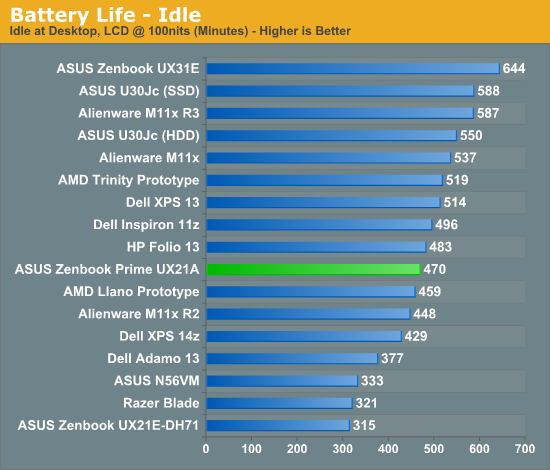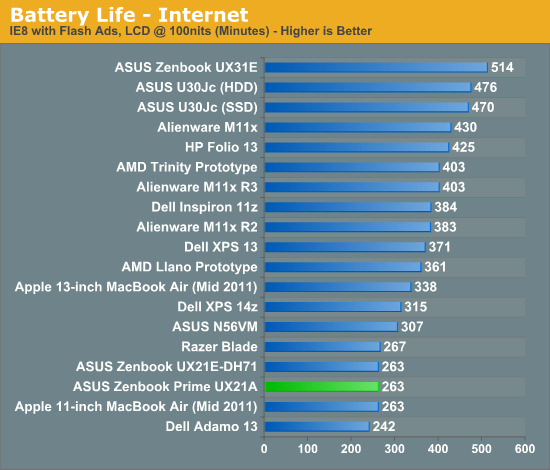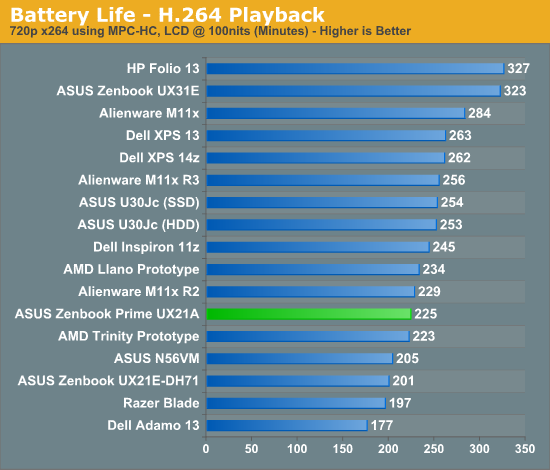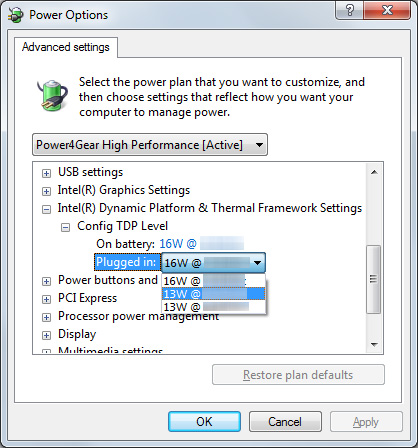ASUS Zenbook Prime (UX21A) Review: The First of the 2nd Gen Ultrabooks
by Anand Lal Shimpi on May 22, 2012 2:46 PM EST- Posted in
- Laptops
- CPUs
- Asus
- Ivy Bridge
- Zenbook
- Zenbook Prime
- Ultrabook
- Notebooks
Battery Life
Generally speaking, the 11-inch Zenbook Prime delivers about the same amount of battery life as its predecessor. For some reason we're able to hit much longer idle battery life on the Prime than the original Zenbook although I'm still trying to find out why. There's also an 11% improvement in our x264 playback test, but on average I'd expect to see similar battery life to the Sandy Bridge model - just with better performance. Note that these results also come despite the fact that ASUS is driving a much higher resolution, and presumably higher power, display than the original Zenbook.



The Zenbook Prime bucks the trend Jarred saw with the first Ivy Bridge notebook review where battery life took a small step backwards. These results bode well for future Ivy Bridge notebooks and Ultrabooks. It still remains to be seen if Intel's 22nm process will actually give us a battery life advantage in any notebook compared to its predecessor. It's possible that we are seeing some of the benefits of 22nm here already and they are simply offset by the more power hungry display. With the move to 22nm Intel should have a better hold on active power and leakage, but it's always possible that we'll have to wait until Haswell for the process to really be exploited.
Just like last time, ASUS has a couple of widgets to quickly change between power settings. The instant on widget lets you switch between suspend to RAM and suspend to disk modes. The former is expected to deliver up to 2 weeks of standby battery life, while the latter can push up to 150 days. I didn't have the time to test these claims (life is short, I draw the line at spending it testing claims of 150 day standby battery life). ASUS once again includes a counter that estimates how long your system will last in either mode based on current charge levels and power usage.
The next widget is a quick tool to let you switch between high performance and battery saver Power4Gear power profiles. You can customize these profiles via the Windows control panel, but it's nice to have a button on the desktop that lets you quickly switch between them.
Configurable TDP
One feature of Ivy Bridge that we haven't been able to test until now is configurable TDP. While most Ultrabook CPUs ship with a 17W TDP, that's mostly an arbitrary thermal/power rating. If an OEM wants to design a chassis that can only accept a 13W part it previously had to hope that Intel would make such a thing. Alternatively, the OEM could underclock/undervolt a 17W chip on their own and hope to mimic Intel's validation and deliver a 13W configuration of their own. The former requires that a significant number of OEMs demand the part, while the latter is just too risky for the larger OEMs (get too aggressive on the undervolting side and end up with a bunch of unstable systems). The solution Intel proposed with Ivy Bridge is configurable TDP. For Ultrabooks this means you can set a 17W part to 13W.

Currently the setting is hidden away in Windows 7's power management settings. Once again I've had to censor the clock speeds here due to Intel's Ultrabook embargo:
You can map the 13W settings to the battery saver profile and then, at the click of a button, have a 13W Zenbook Prime instead of a 17W model. The difference in performance isn't significant however:
| ASUS Zenbook Prime Configurable TDP Performance - Cinebench 11.5 (Multithreaded) | |||||||
| 16W - Max Freq | 13W - Mid Freq | 13W - Lowest Freq | |||||
| ASUS Zenbook Prime UX21A | 2.79 | 2.67 | 2.67 | ||||
I'm still running battery life tests to quantify the impact on power consumption, but it's conceptually a neat thing to see in action finally. I suspect configurable TDP is going to play a major role with Haswell and convertible/dockable Ultrabook-tablet hybrids.
Thermals and Noise
As with most high performance notebooks that are this thin, cooling is difficult. Under load the fans in the Zenbook Prime are definitely audible, but in general ASUS does a better job cooling everything inside the Zenbook Prime than Apple does in the MacBook Air. I suspect much of this boils down to how aggressive Apple is about keeping fan speed/noise down compared to ASUS' desire to maintain a certain temperature level inside the chassis.










192 Comments
View All Comments
joe898 - Wednesday, May 23, 2012 - link
I guess you don't care about the annoyingly large bezel.Sunburn74 - Wednesday, May 23, 2012 - link
You're looking at the 11inch model and so the bezel seems amplified. A larger screen size makes that bezel seem more appropiate.That withstanding, the machine still looks phenomenal bezel and all.
joe898 - Wednesday, May 23, 2012 - link
Yes, I'm specifically looking for an 11.6" ultrabook. I'd actually sacrifice thinness to get the bezel and hence, the foot print smaller. The bezel on the 11.6" Asus makes the notebook look very cheap too.Bolas - Wednesday, May 23, 2012 - link
So when and where can I buy one of these?Sunburn74 - Wednesday, May 23, 2012 - link
Agreed. If I could pre-order, I would.cwcwfpfp - Friday, May 25, 2012 - link
No official release date yet. A reasonable guess is that it will be available shortly after Computex though, which takes place June 5-9.DaveStall - Thursday, May 24, 2012 - link
I am a little bit curious about this comment in the review in resepect to noise:" I suspect much of this boils down to how aggressive Apple is about keeping fan speed/noise down". My wife has a current model 13" MBA and that thing sounds like a cross between a hair dryer and a leaf blower if she is doing anything remotely intense (which for her tends be be playing Flash based Facebook games). We are honestly ready to sell the MBA because of noise issues. If the Zenbook is louder than the MBA then the noise must be almost unbearable. That's too bad beuase I was hoping this would be something I could replace her MBA with.Malih - Saturday, May 26, 2012 - link
wondering how does Apple go from high-priced laptop to providing better value,but with good display, SSD, and Thunderbolt they have a competitive advantage compared to UX32A-DB51,
or is there a catch with Apple?
Enigmat - Saturday, May 26, 2012 - link
Is the HDD changeable? like changeable to a 7mm ssd ??Mhefnawy - Sunday, May 27, 2012 - link
can we Connect External Monitor to Asus Ultrabook and turn it's own off to check battery life with external screen while the internal is almost off to remove internal display backlight power from battery to identify how longer it will stay with its internal screen compare to external display then we do the same with the previouse model to check the value added by ivy bridge in battery life terms???